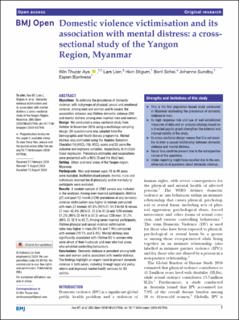| dc.contributor.author | Aye, Win Thuzar | |
| dc.contributor.author | Lien, Lars | |
| dc.contributor.author | Stigum, Hein | |
| dc.contributor.author | Schei, Berit | |
| dc.contributor.author | Sundby, Johanne | |
| dc.contributor.author | Bjertness, Espen | |
| dc.date.accessioned | 2021-02-15T10:10:21Z | |
| dc.date.available | 2021-02-15T10:10:21Z | |
| dc.date.created | 2020-11-06T14:05:01Z | |
| dc.date.issued | 2020 | |
| dc.identifier.citation | BMJ Open. 2020, 10:e037936 (9), 1-13. | en_US |
| dc.identifier.issn | 2044-6055 | |
| dc.identifier.uri | https://hdl.handle.net/11250/2728007 | |
| dc.description.abstract | Objectives To estimate the prevalence of domestic violence, with subgroups of physical, sexual and emotional violence, among men and women and to assess the association between any lifetime domestic violence (DV) and mental distress among ever-married men and women. Design We conducted a cross-sectional study from October to November 2016 using a multistage sampling design. DV questionnaire was adopted from the Demographic and Health Survey programme. Mental distress was estimated using the Hopkins Symptom Checklist-10 (HSCL-10). HSCL-score and DV were the outcome and exposure variables, respectively, in multiple linear regression. Prevalence estimates and associations were presented with a 95% CI and the Wald test. Setting Urban and rural areas of the Yangon region, Myanmar. Participants Men and women ages 18 to 49 years were included. Institutionalised people, monks, nuns and individuals deemed too ill physically and/or mentally to participate were excluded. Results A random sample of 2383 people was included in the analyses. Among ever-married participants, lifetime (LT) and past-12-month (12M) prevalence of any domestic violence victimisation was higher in women compared with men: LT women: 61.8% (95% CI: 54.3 to 68.9) versus LT men: 42.4% (95% CI: 37.5 to 47.5) and 12M women: 51.2% (95% CI: 44.9 to 57.5) versus 12M men: 37.7% (95% CI: 32.9 to 42.7). Among never-married participants, lifetime physical and sexual violence victimisation rates was higher in men (34.3% and 7.9%) compared with women (19.1% and 6.4%). Mental distress was significantly associated with lifetime DV in women who were afraid of their husbands and men who had wives who exhibited controlling behaviours. Conclusions Domestic violence is prevalent among both men and women and is associated with mental distress. The findings highlight an urgent need to prevent domestic violence in both sexes, including through legal and policy reform and improved mental health services for DV victims. | en_US |
| dc.language.iso | eng | en_US |
| dc.publisher | BMJ Publishing Group | en_US |
| dc.relation.uri | https://www.ncbi.nlm.nih.gov/pmc/articles/PMC7497540/pdf/bmjopen-2020-037936.pdf | |
| dc.rights | Navngivelse-Ikkekommersiell 4.0 Internasjonal | * |
| dc.rights.uri | http://creativecommons.org/licenses/by-nc/4.0/deed.no | * |
| dc.title | Domestic violence victimisation and its association with mental distress: A cross-sectional study of the Yangon Region, Myanmar | en_US |
| dc.type | Peer reviewed | en_US |
| dc.type | Journal article | en_US |
| dc.description.version | publishedVersion | en_US |
| dc.source.pagenumber | 1-13 | en_US |
| dc.source.volume | 10:e037936 | en_US |
| dc.source.journal | BMJ Open | en_US |
| dc.source.issue | 9 | en_US |
| dc.identifier.doi | 10.1136/bmjopen-2020-037936 | |
| dc.identifier.cristin | 1845671 | |
| dc.relation.project | NORHED: MMY-13/0049 (MY-NORTH-1300650) | en_US |
| dc.description.localcode | © Author(s) (or their employer(s)) 2020. Re-use permitted under CC BY-NC. No commercial re-use. See rights and permissions. Published by BMJ. | en_US |
| cristin.ispublished | true | |
| cristin.fulltext | original | |
| cristin.qualitycode | 1 | |

